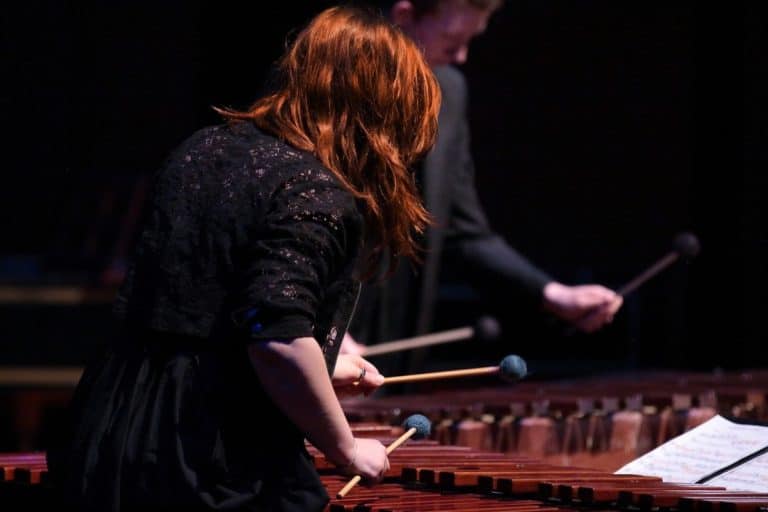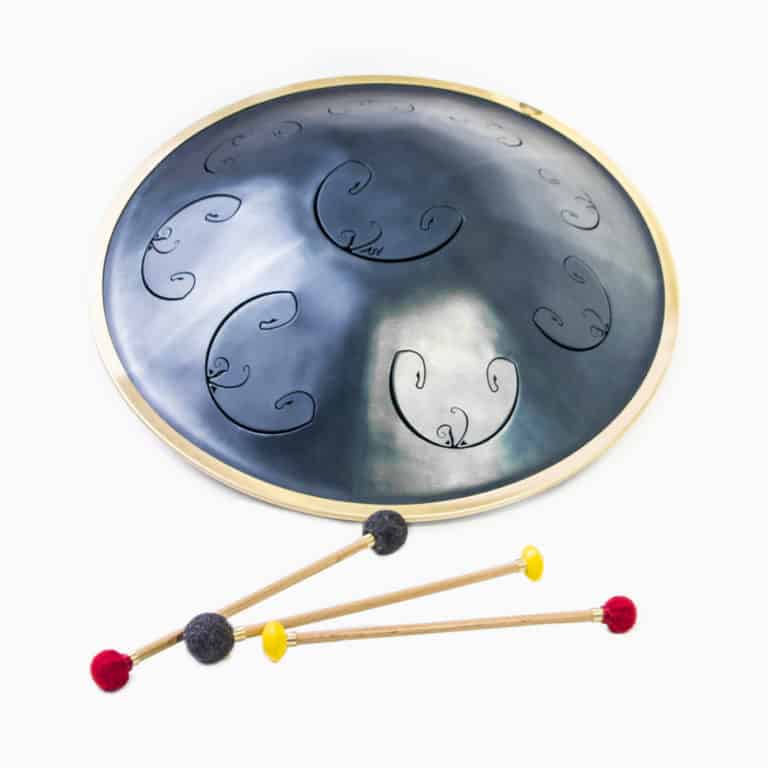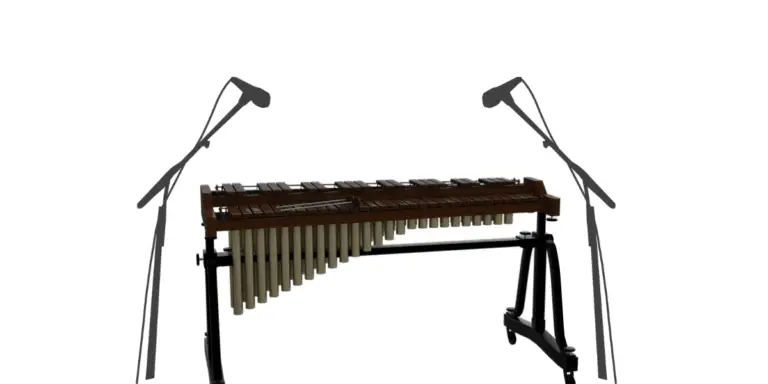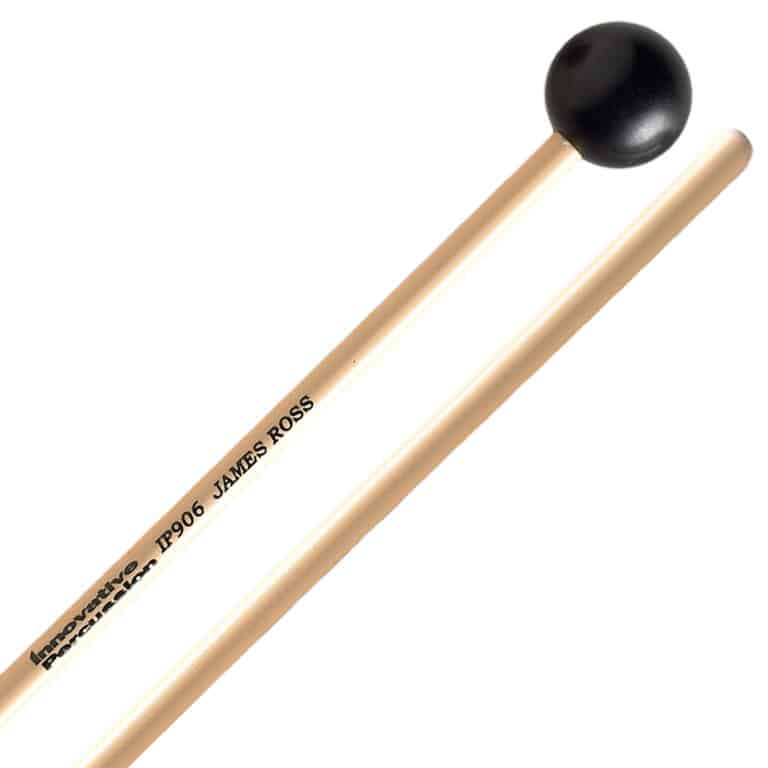Easy Marimba Instrument History (Origin, Development & Today)
This is a brief but still comprehensive look at the history of the Marimba from its origins right through to the modern-day and some restrictions on who can play it, depending on your geography in the world.
When was the Marimba Instrument Invented? – The Marimba’s invention began in the 14th Century, although its country of origin is not universally agreed upon. The Marimba of today was developed in the early 20th century by two American crafters, J.C. Deagan and U.G Leedy and continues to be an ever-present member of the percussion section of the orchestra.
Let’s go on the journey from the beginning until today, and find out more about where the marimba came from, the influences that have shaped its development through to the modern-day
The Marimba´s origins
Marimba’s history is uncertain in many aspects. Being recognized as one of the first man-made melodic instruments, little is known about its origins. Many countries claim to have created it, but there’s no concrete evidence of those affirmations.
However, historians suggest that it spread starting from South East Asia and Africa circa the 14th century and reached South America in the beginnings of the 16th century.
Since then, it has become a popular folkloric instrument in South and Central America. The Asian version of the story, that diverges from the African origin, alleges that the marimba finds its origins in Asia, due to the resemblance of the instrument to the “Pong Lang”, native from Thailand or the “Mokin” from Japan. Nonetheless, African origins are more generally accepted.
Why is it Called Marimba?
The “Marimba”, as a name for the instrument, is derived from African languages (more specifically the Bantú language) and is one of the various names for the instrument known as the “xylophone”.
However, this musical instrument is known by many different names according to the geographical location where it comes from and its physical characteristics.
Physical characteristics and playing styles
Speaking about its physical properties and characteristics, the marimba is a percussion instrument that consists of a series of wooden bars strung tightly to each other over a wooden surface that holds them in the air and enables them to produce musical tones.
Beneath the wooden surface and under each bar, resonators or pipes are placed to amplify the sound that the instrument produces. The length of the resonators can vary depending on the frequency that the wooden bar has, and amplifies the sound similar to the way in which a guitar’s body would.
Each bar is placed in a specific order, according to a predefined chromatic scale, similar to the keys of a piano.
Marimba is in the idiophone class
The instrument is what in a musical context is known as an idiophone, but differentiates itself from the xylophone because of the lower-pitched tones that it produces and the buzzing membrane that is set to sharpen the sound emanated.
Generally, the marimba is sounded by striking the wooden bars with a special kind of drumstick by a person called a “marimbist” or a “marimba player”. This instrument, depending on its size, can be played by up to four musicians.
The technique behind the drumsticks -or mallets– depends on the number of mallets that the player uses. If more than one mallet is used in each hand, the performer will be able to play chords more easily.
2-Mallet Grip Techniques
- Burton grip
- Traditional Grip
- Musser-Stevens Grip
The mallets are held using different kinds of grips: for two mallets in each hand, the players prefer to use a “Burton Grip”, the “Traditional Grip” or the “Musser-Stevens Grip”.
A player may identify benefits and drawbacks from each, depending on the speed necessary to play the piece or the freedom needed.
Aside from that, players may have a preferred grip because of their geographical location. For instance, the burton grip is commonly used in the United States, while a traditional grip is often used in Japan.
Six mallet grips are also possible. In this situation, the player grips three mallets between his fingers. This is considered a non-classical approach to the marimba. Nonetheless, six mallet grips have been used for many years by players from Central America and Mexican musicians.
The Marimba was originally much smaller and tied to the player
In its origins, the instrument was tied to the musician’s waist or was laid across the legs of the player, who usually sat in the ground to play.
The materials used were rudimentary and consisted of carved branches of a tree that served for a variety of purposes, such as the construction of strips (to hold the instrument when playing while standing), handles (to carry the instrument around), wooden bars, etc.
Marimba Sound is based on Materials used in History
In its early stages, the sound of the instrument varied according to the type of wood used and the size of the resonators. For instance, if the wooden bars were carved to be thin, the result would be a lower tone pitched marimba. This practice was widely used to “tune” the instrument as there were no other tunning systems.
The Arrival of the Marimba to South America
It is interesting to address the arrival of the instrument to the coastal areas of Central and South America from Africa, considering the significant distance between the two geographical locations.
How did the Marimba Arrive in South America? – The Marimba instrument is believed to appear in South America with the shipment of slaves who brought knowledge of the instrument with them. Either building the instrument as a reminder of home or sharing it within relations with the Indian slaves in the same area and period.
During the 16th century, it was common to observe African slaves being brought to America. These slaves were forced to serve as the basic labor force in the new land and consequently bonded with the Indian cultures that inhabited the área, who were also enslaved for the same purposes.
The relations created among these men may have been the source of the knowledge transmission of this unknown instrument for the Indians.
Marimba in Guatemala and Its Position as the National Instrument.
In the middle of the uncertainty around the origins of the marimba, one thing is certain: the instrument managed to spread effectively throughout the entire region of Central America, developing greatly in the region of Guatemala.
Yet, since there’s no true information regarding the region from which the marimba came to America or even where the marimba was introduced, its a difficult task to determine how the instrument was played and which cultural influences were adopted because of it.
Nevertheless, there’s some evidence of marimbas with calabash resonators and various parts of the instrument were found in large quantities in the region of Guanacaste, a coastal region in Costa Rica that borders with Nicaragua.
Of course, this evidence does not eliminate the possibility that the first instruments were introduced in Central America. In any case, Guatemala claims to be the precursor of this instrument. This nation declared marimba its national instrument in 1978 due to the profound impact on its culture and its society.
Large marimbas covering up to six and a half octave and are commonly known as “xylorimbas”. They are generally found in certain villages of Guatemala and Mexico. Because of its size, this kind of marimbas are played by more than one person from a standing position.
Marimba Instrument in Columbia and Ecuador
The marimba is also typical of South American countries such as Colombia and Ecuador. In Colombia, the instrument is emblematic of the pacific traditional music and is crafted with a very resistant plant called the “Guadua” for the resonators and 23 wooden sheets of different sizes and shapes that give it its characteristic sound.
To play the instrument, it is hung to the roof and it is played by two marimbists. The marimba is seen in bands named by the name of the instrument and is essential in many celebrations such as the “cununao”, one of the most important traditions in the pacific coast.
In Ecuador, the marimba was recognized to be included in the Representative List of the Intangible Cultural Heritage of Humanity. This recognition does not only include the instrument but the knowledge around it.
New Marimba Instrument Developments
Although the instrument started being rudimental, as time has passed, new materials have been used to craft marimbas, however, its essence has remained intact.
Modern marimbas such as the orchestral marimba, are built using rosewood and aluminum or brass for the resonators.
Padauk wood is also an affordable alternative for Rosewood. Some will claim this is a compromise for sound quality, but others are not so convinced and some very good instruments have been made with Padauk.
The Deagan and Leedy Marimba
This type of marimba instrument was developed in the early 20th century by two American crafters, J.C. Deagan and U.G Leedy, and introduced new ways of playing the instrument.
For example, this marimba can have a two-level keyboard and is played commonly with two special drumsticks in each hand, allowing the player to play up to four notes at a time. In other words, the new designs of the marimba facilitate the player to play the full chromatic scale.
The orchestral marimba often has a range of four octaves. Still, there are bigger marimbas that cover up to six and a half octaves.
First Concert Hall Marimbas
The first appearance of a marimba in a concert hall was made possible thanks to the efforts of the “Clair Omar Musser marimba ensemble” around the early 1930s in the Chicago’s World Fair. After this event, new players have joined and created compositions for orchestral marimba, including Paul Creston and Darius Milhaud.
Paul Creston
Paul Creston was an Italian-American self-taught composer of classical music. His first major work for the Marimba was the “Concertino, Op. 21” which was written in 1940 and it is considered one of the most important musical pieces today.
This musical piece recognition was due to the features that made it less predictable than the common xylophone style, which required only two mallets to interpret.
Paul Creston is often seen as a very creative mind, mainly because of the approach to the Marimba that he had. Essentially, he used his piano knowledge and skills to transform the different techniques to the Marimba language.
This was a remarkable work, that differed substantially from previous works, and was taken as an inspiration for many other artists that followed him.
Darius Milhaud
Another renowned artist was Darius Milhaud, whose most important work of art was the “Concerto, Op. 278 for Marimba and Vibraphone” for one marimbist. The idea behind writing music for the Marimba was to apply the knowledge and expertise he had on previously written concerts for percussion, clarinet, and harmonica.
The result was the “concerto” pice which could be described as a “French Version of Latin Jazz”. (Kastner, 1989)
Marimba Instrument Teaching Methods
There are two main teaching methods when learning to play the marimba.
- Ngoma Style
- Musical Notation
Ngoma Style
On one hand, there is the ngoma style which is taught in Africa, Mexico, Guatemala and regions where the multisensory practice is often used. In this kind of culture, people who teach are merely guides, who show a personal way to perform and allow their students to create their skills and styles.
The ngoma style is then, a way of teaching that involves learning through imitation and repetition.
The introduction of new technologies has changed the way the ngoma style is taught. Audio and video are now common for students who are learning the arts of imitation.
One may think that the use of modern technology seriously contravenes the spirit of the ngoma, however, if all the senses are involved in the process, its essence is preserved.
Contrary to what people may think at first, ngoma instruments are learned and played because they have a profound societal role in the culture of the regions and people’s lives in general.
The marimba is not only a source of entertainment and leisure, but it is also widely used in communities’ rituals and is considered more than a simple instrument, its a symbol of identity and patriotism. For instance, the marimba is often heard in ceremonies or events such as weddings, funerals, harvesting rituals, and even sports. Therefore, people learn to play to be able to participate in daily life experiences.
Musical Notation
On the other hand, the second method used in the process of learning marimba is musical notation. This modern approach to the instrument does not rely solely on imitation and repetition, because it involves an academic setting. People who learn to play the marimba through this method, are most commonly deeply involved with music learning and have studied for several years to play more than one instrument.
Difference between Ngoma and Musical Notation
As seen before, the two methods of teaching differ from each other in diverse dimensions but are similar in others.
The differences usually reside in the creation (or composition) of the music. One of the elements that vary is known as a musical form.
The ngoma style is written without a specific musical structure, which can be referred to as free form music. A second example is the binary songs, which are essentially songs written in two parts that are continuously repeated. The binary songs are representative of the ngoma tradition.
A third example may be the tempo variations, which determines whether a song is danceable or not. In the ngoma tradition, the tempo is constant and there are not many variations as the music is meant to be danced, while the tempo in western music varies at any time during a song.
A final example may be melodic patterns and techniques. These patterns are most frequently found to be short and descending in some regions in the north of Africa and are played to resemble the voice of the singer and contour it to give it a new meaning. Notational music does not contour the voice.
Marimba and Musical Genres
The modern studies of the marimba involve playing all kinds of music genres and knowing notation in general, which is frequently observed as a requisite to perform among western music bands.
This is because learning the instrument by ear limits the person’s ability to perform by the highest standards. Nowadays, there are various exponentials that are recognized internationally for their compositions using the marimba, for example,
- The Nandayapa Brothers from Mexico
- Keiko Abe, a renowned artist from Japan
- “Papa Roncón y Rosa Wila” from Ecuador
Modern composition techniques
Modern composition techniques with marimbas divide the players and instruments in different roles and play various melodies at the same time.
This makes the execution more complex, but grants charm and bright to the music played. On top of that, the marimba is accompanied by a series of instruments that complement the rich sound of the marimba.
Those instruments can be violins, guitars, basses and many more. There are also bands called “orchestra marimbas”, that include wind instruments in their repertoires.
When considering Marimba compositions, many questions must be answered. For example, what is going to be the focus of the composer about tempo, rhythm, tonalities and even mood of the musical piece?
Therefore, the future of marimba composition relies on unique instrumental compositions, the use of electronics to enhance the sound and the use of instrumental combinations, which may seem irregular or random at the beginning, but may bring new approaches and create opportunities around the composition.
Gender Roles and Culture Influence
While the instrument has become widely used around the world and is constantly being modernized, gender and culture are still two important factors when referring to marimba music.
Gender roles understood as social roles that are considered appropriate for people according to the perceived sex of the person is very influential in some contexts.
In some African cultures, the instrument is reserved for men, while in numerous pacific cultures the marimba is often played by women.
However, the new generations are overcoming these barriers as new ideas and thoughts around the subject are rising because of the globalization and open-minded trends.
Conclusions
In sum, the marimba has transcended the eras of men, maintaining its essence and cultural background. Although it has suffered many transformations in the different regions where it is played, these changes have helped the instrument to remain relevant, adapting to all kinds of music genres, such as jazz, classical music, and even rock.
It seems that the popularity of the marimba will prevail, as it has become a central part of many cultures in Africa and America. Most certainly, compositors will find a way to innovate with this instrument to create unheard music and understand new methods to teach the new generations.
REFERENCES:
https://engagedscholarship.csuohio.edu/cgi/viewcontent.cgi?article=1005&context=clmusic_facpub
https://www.britannica.com/art/marimba
https://www.pas.org/docs/default-source/thesisdissertations/Kastner.pdf






